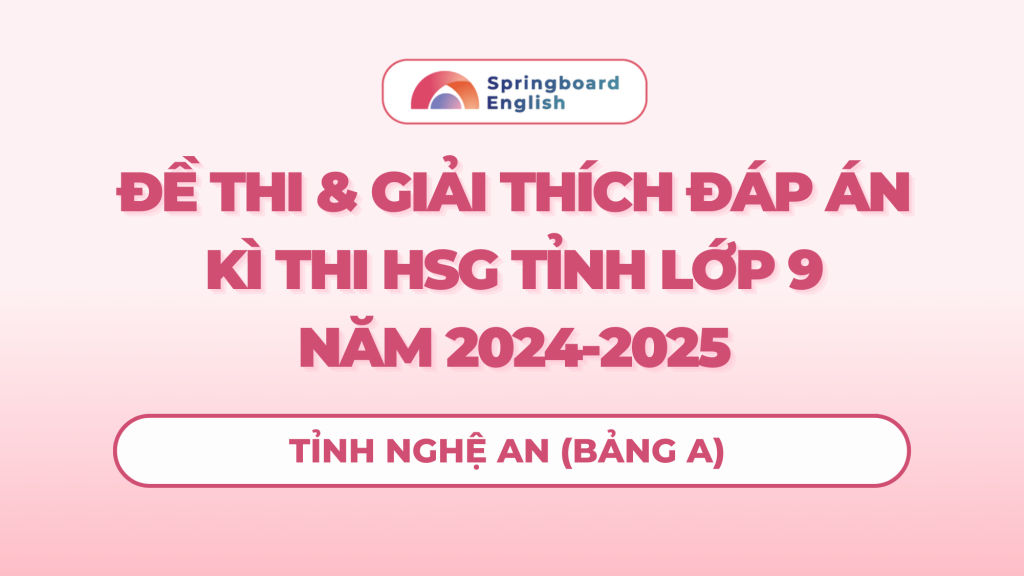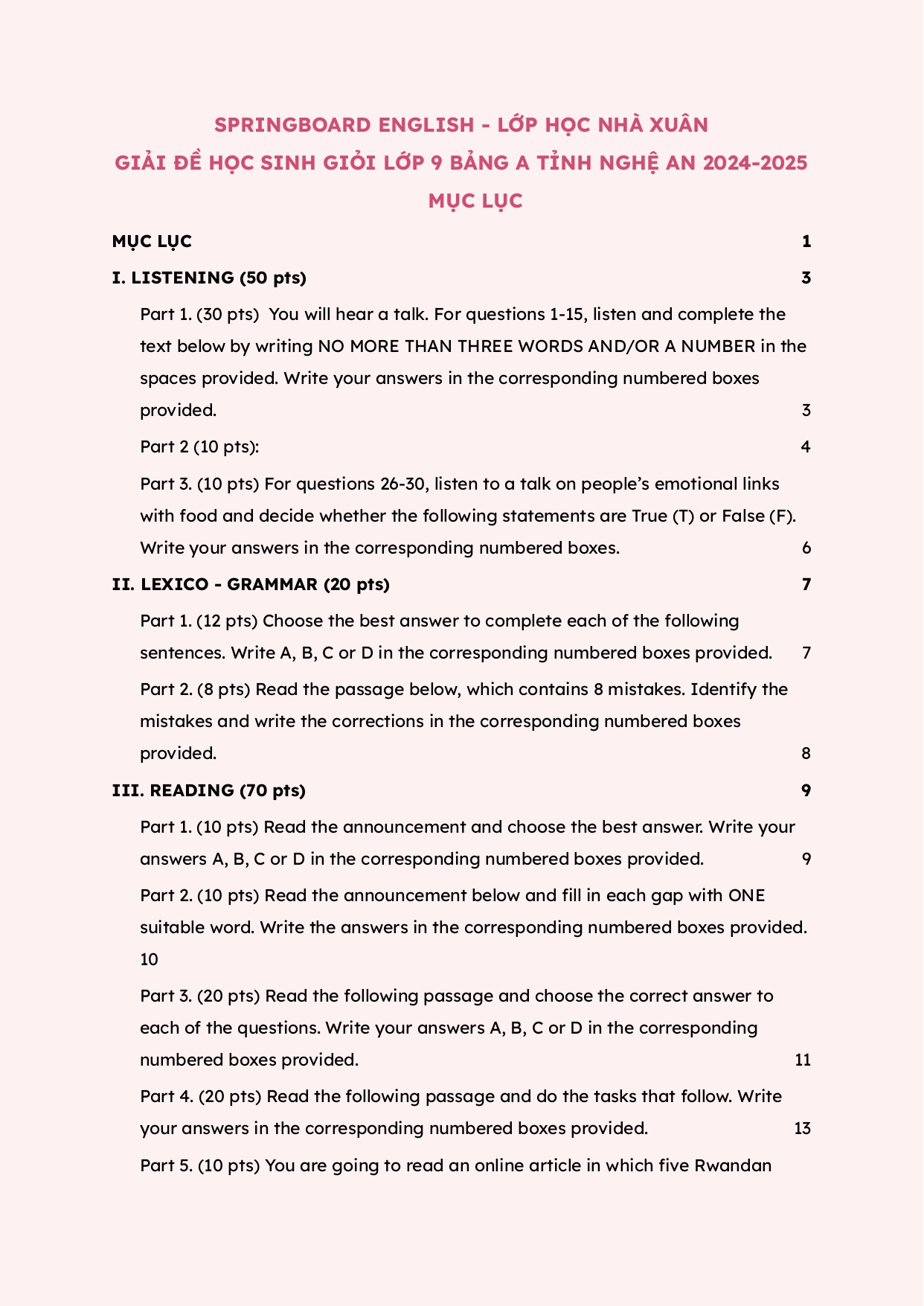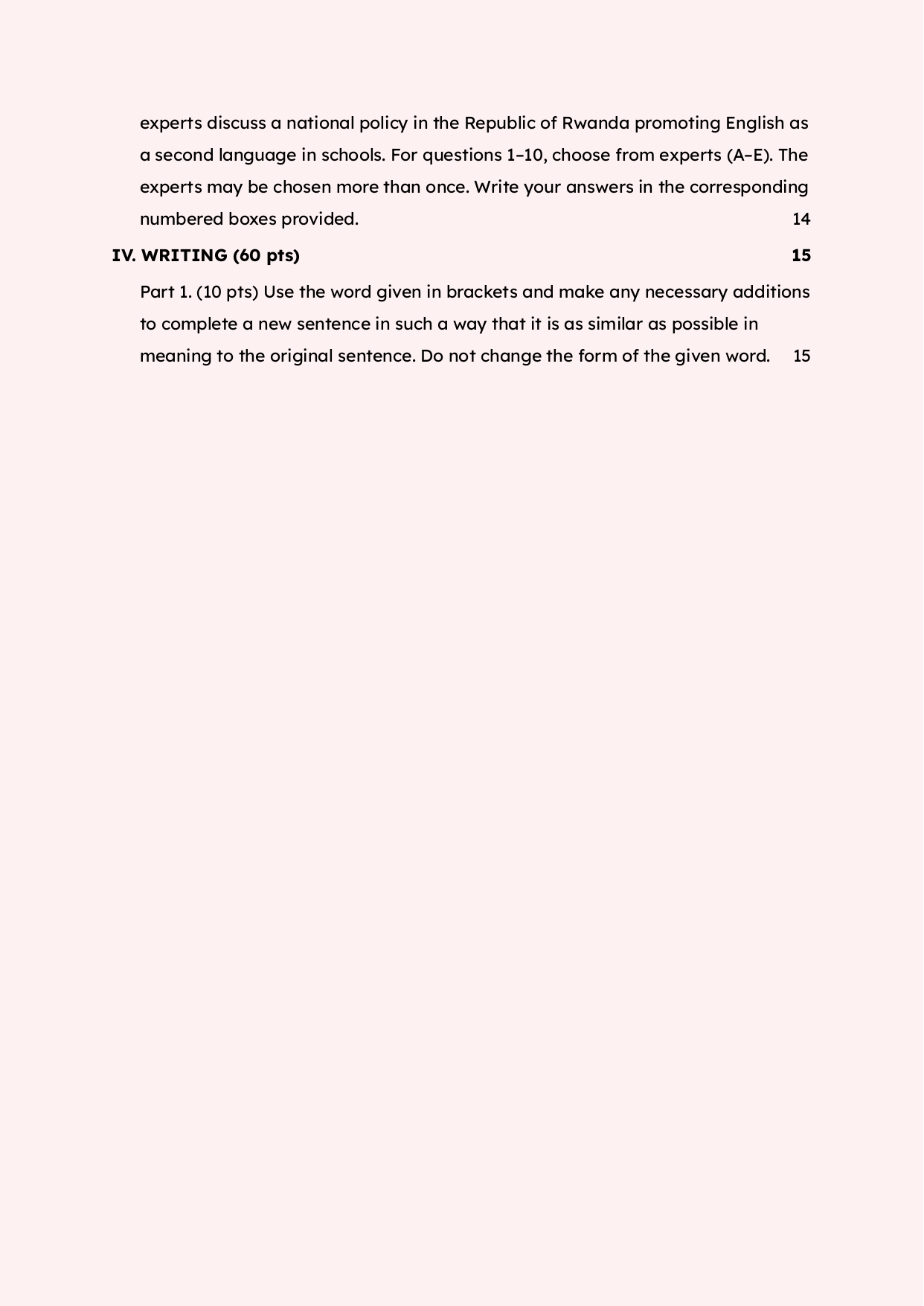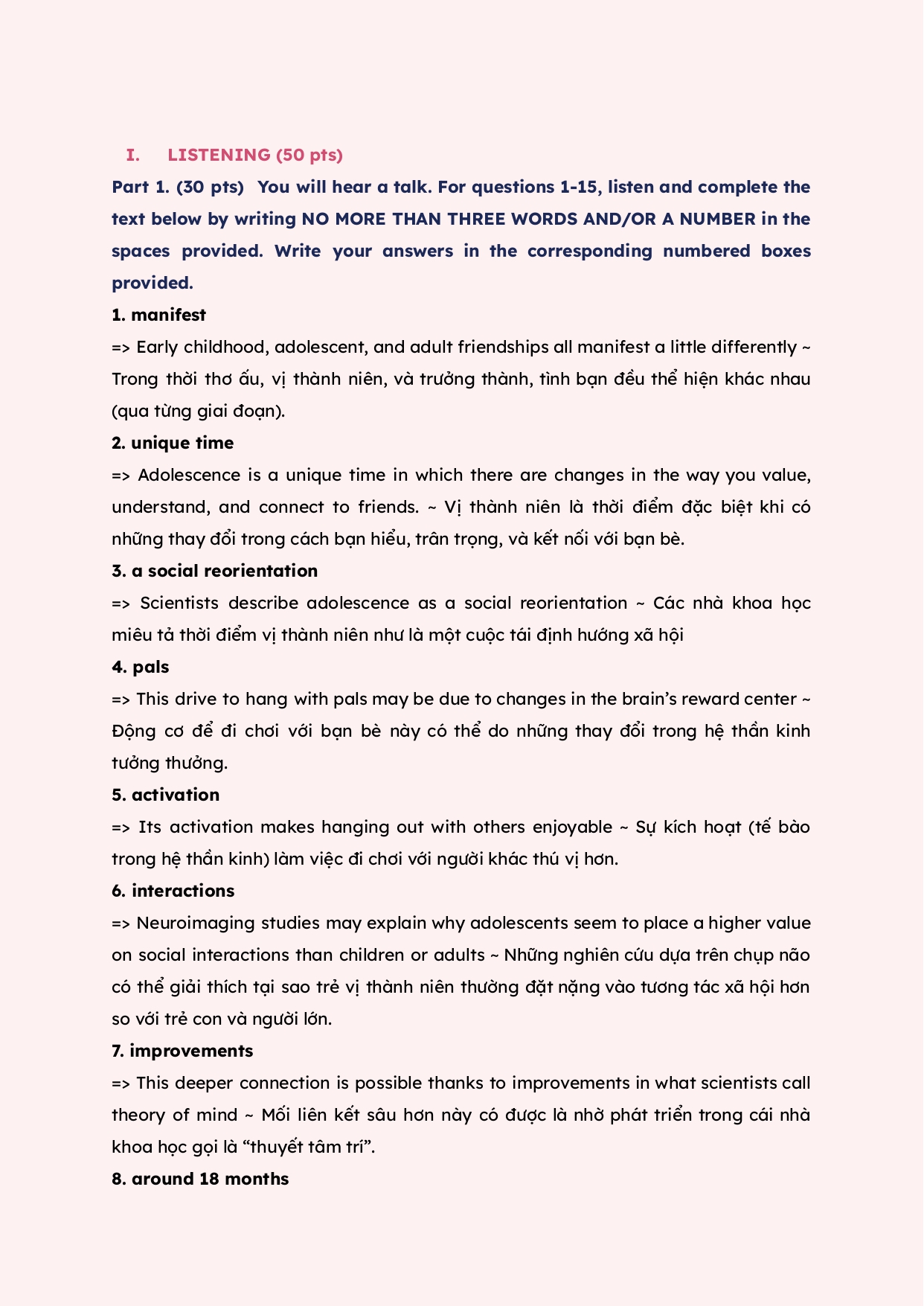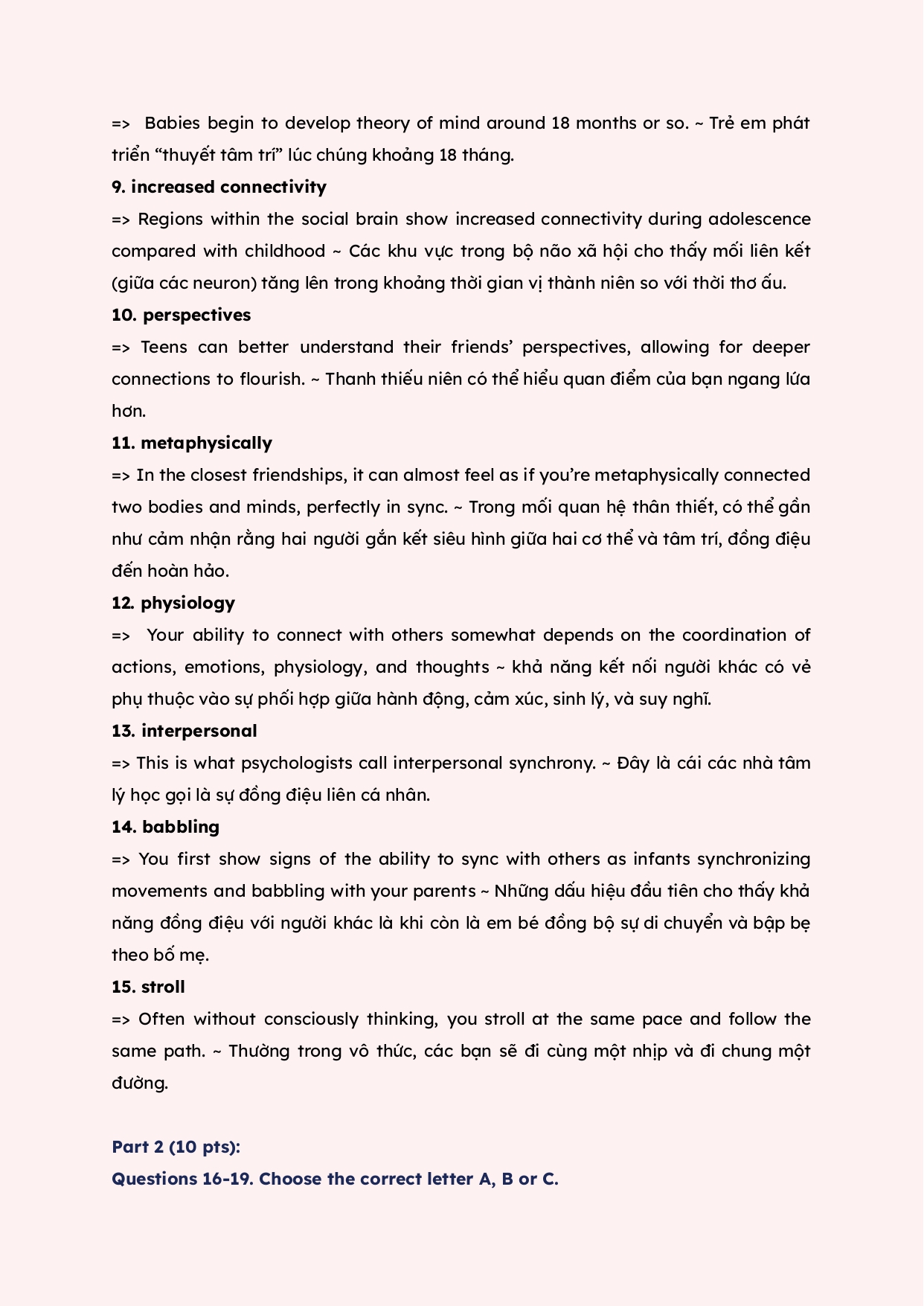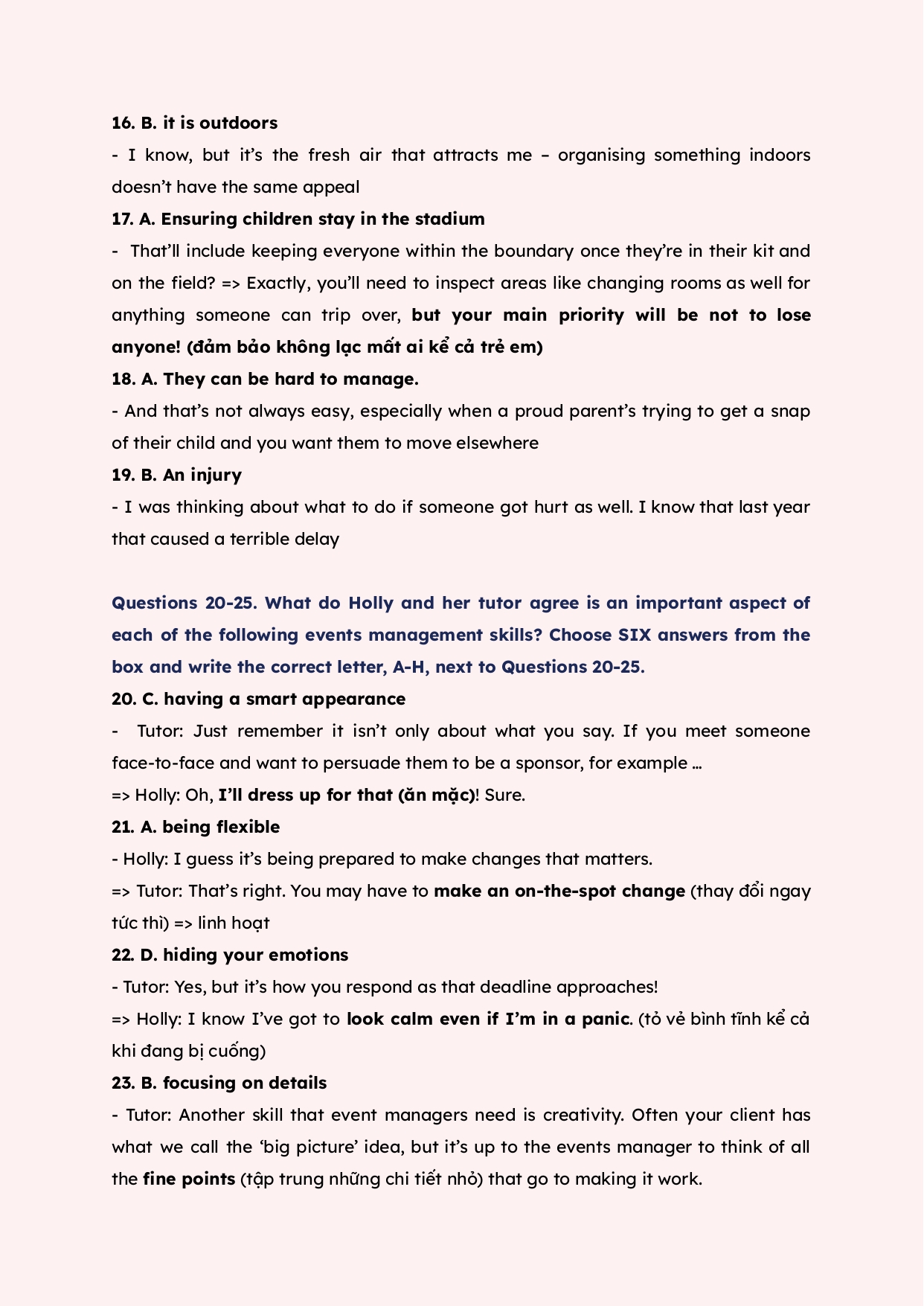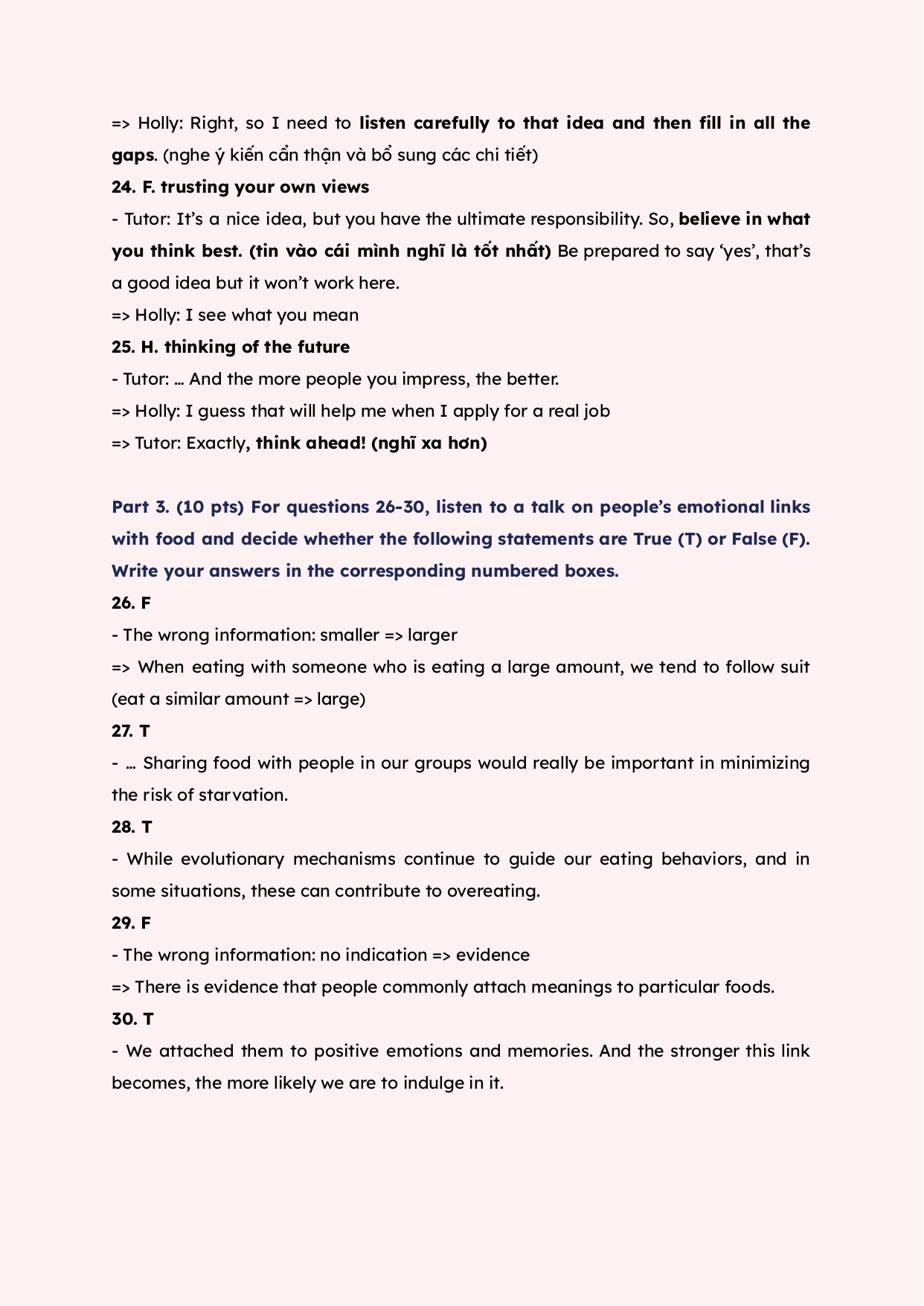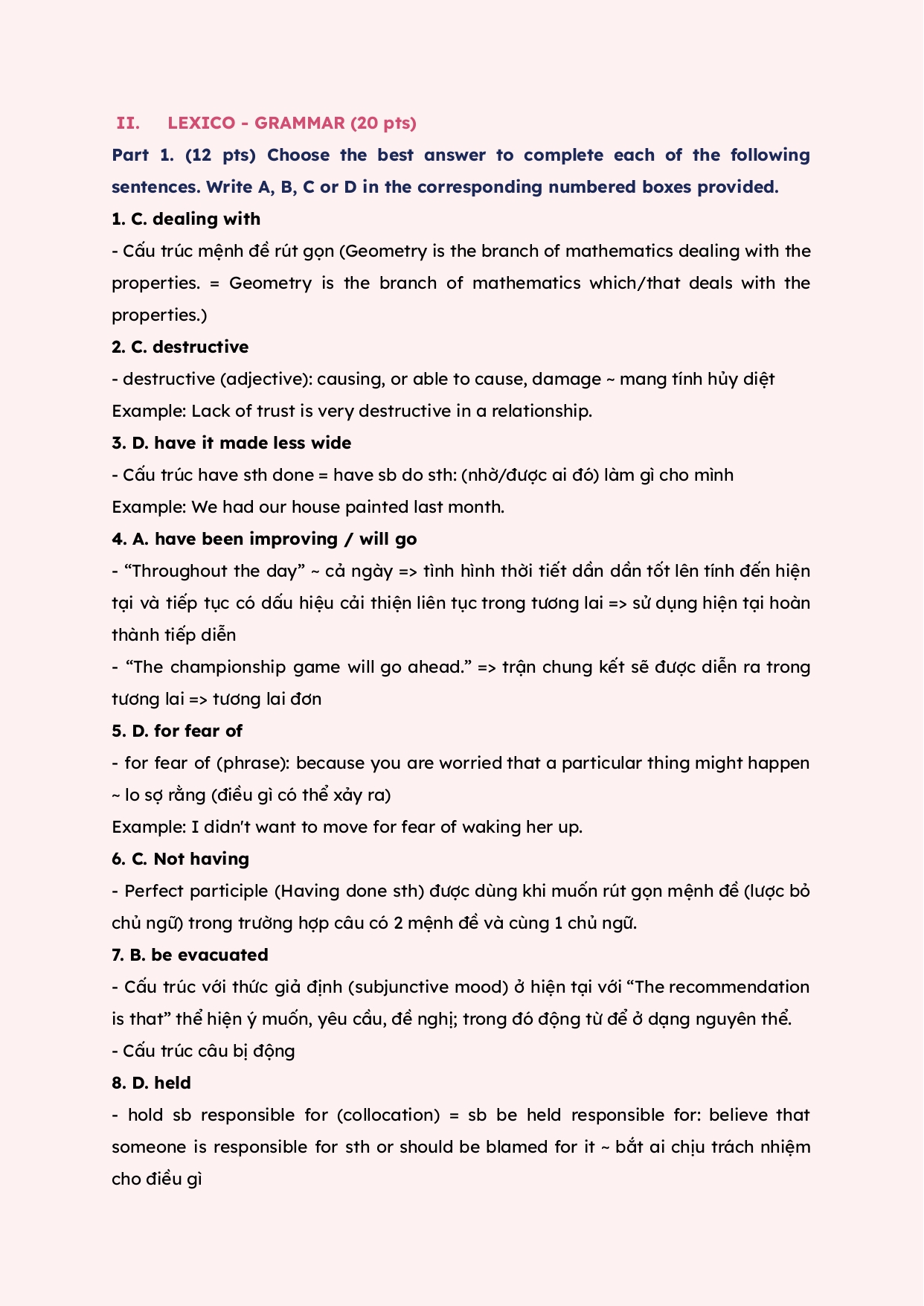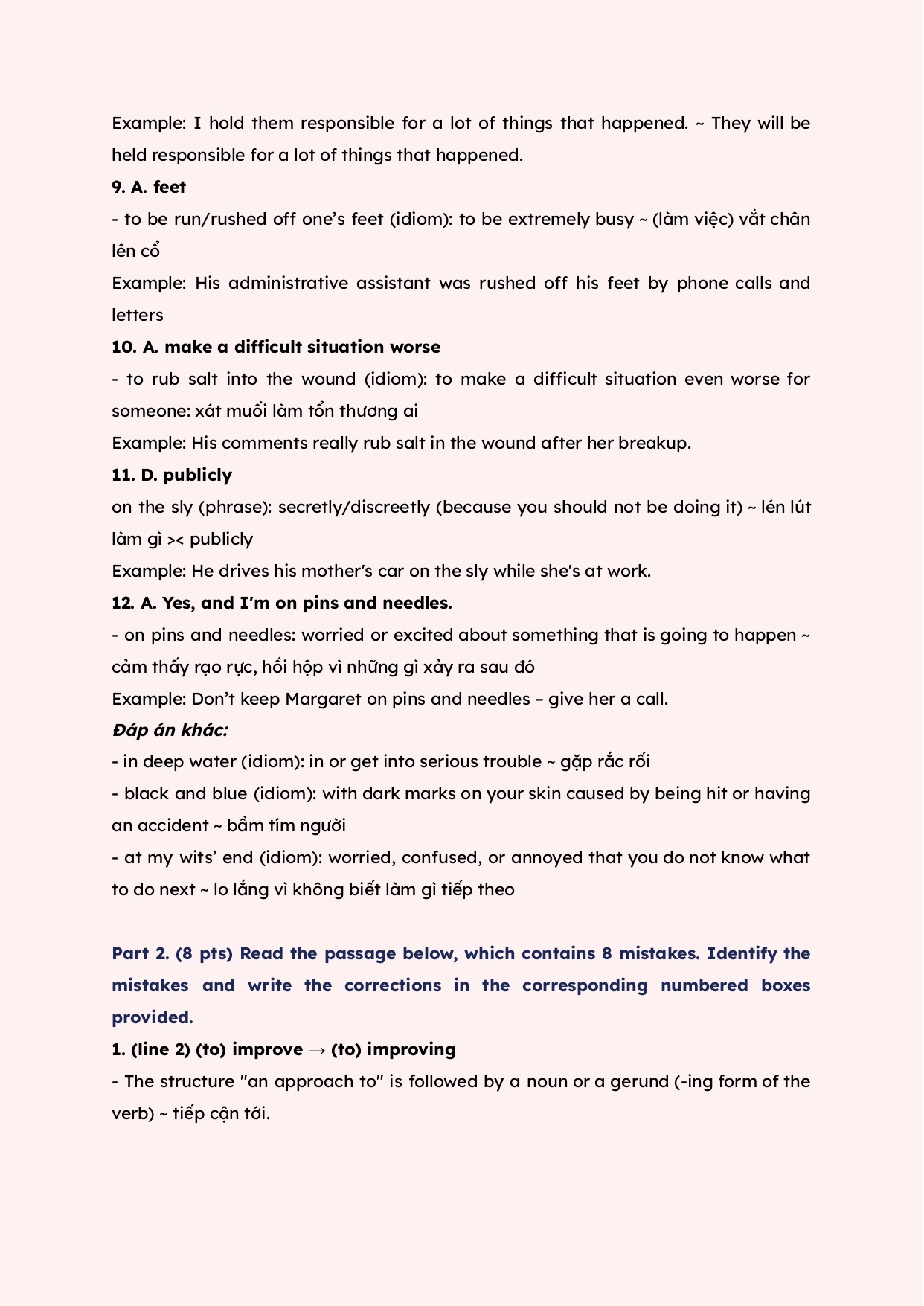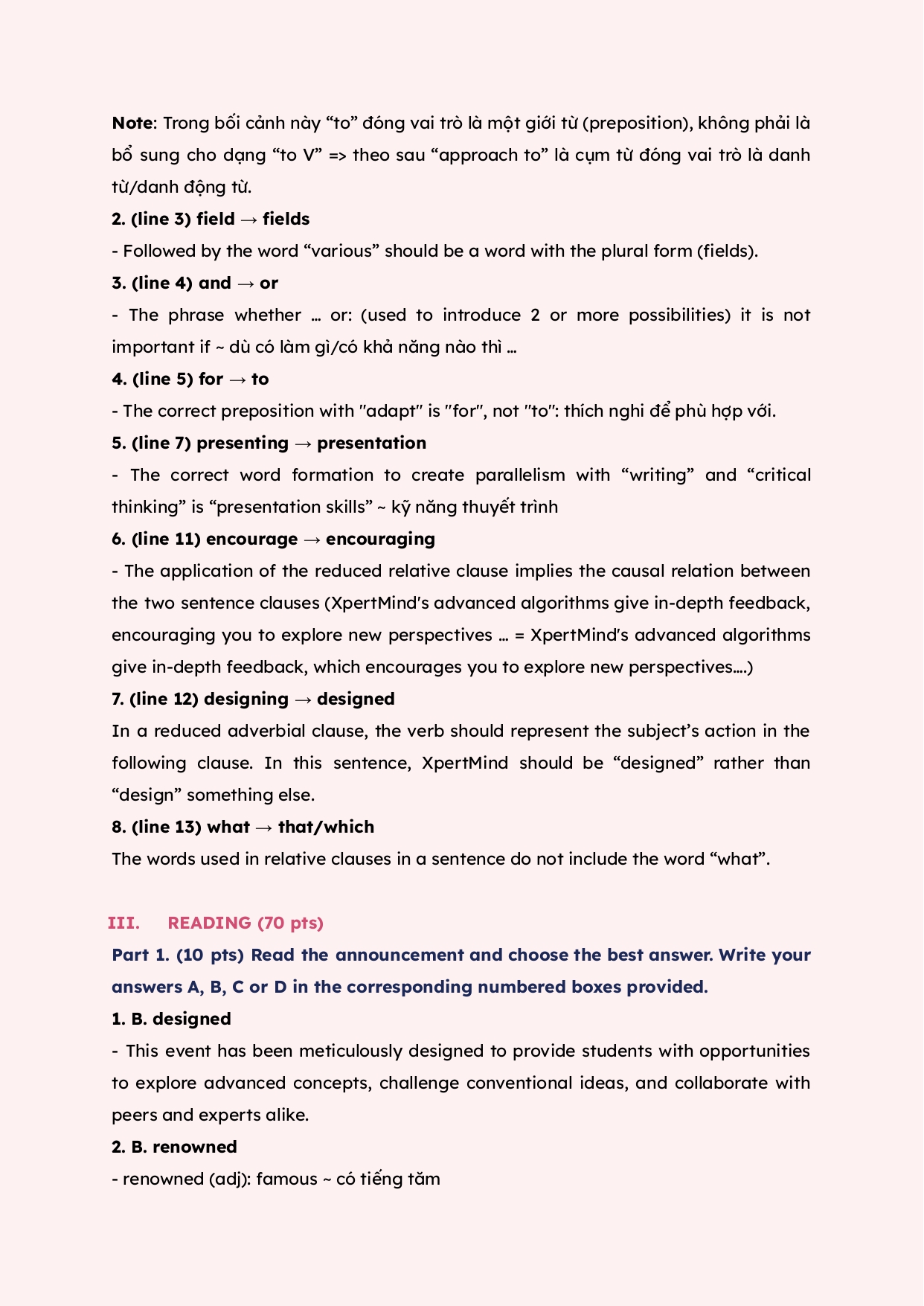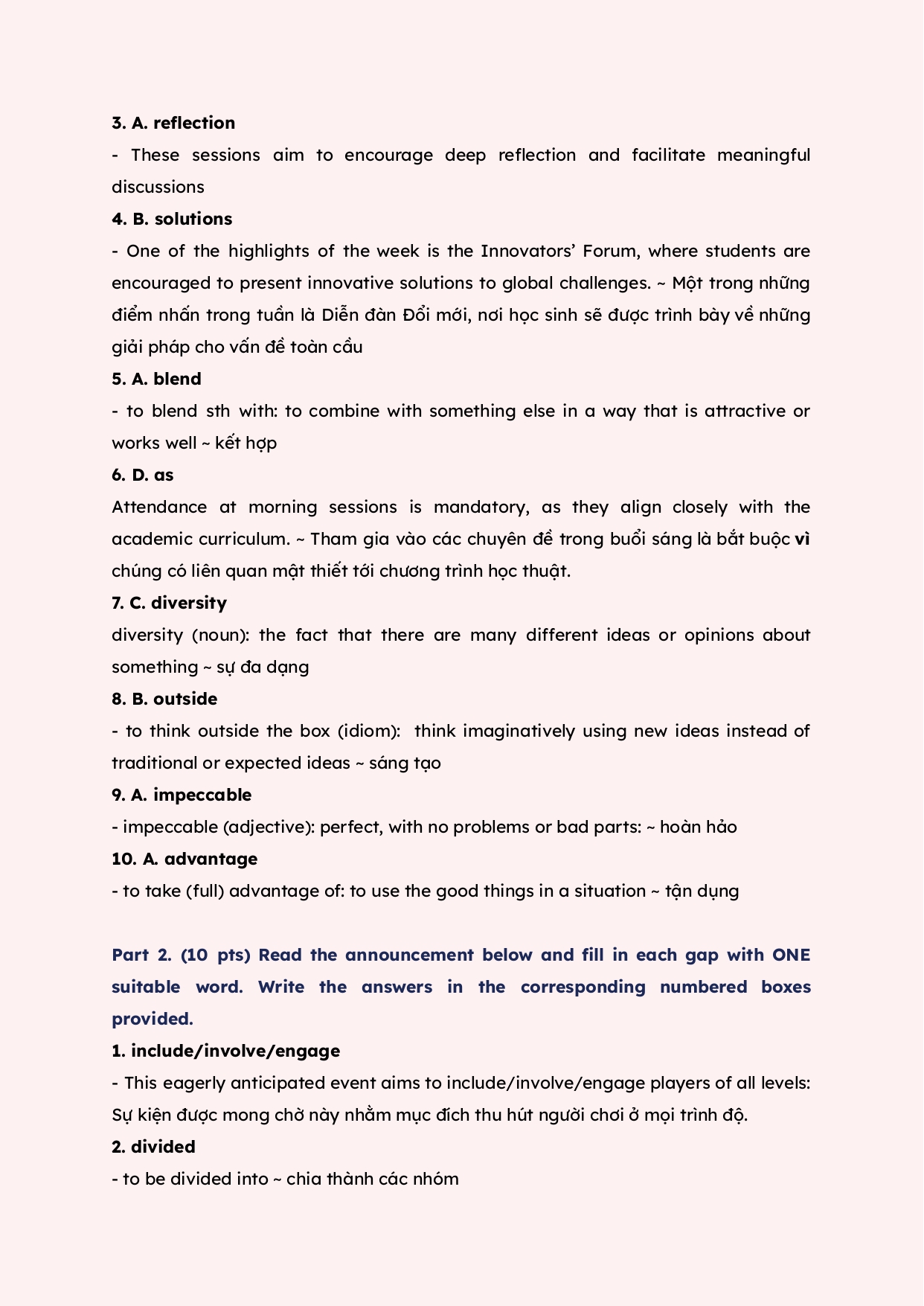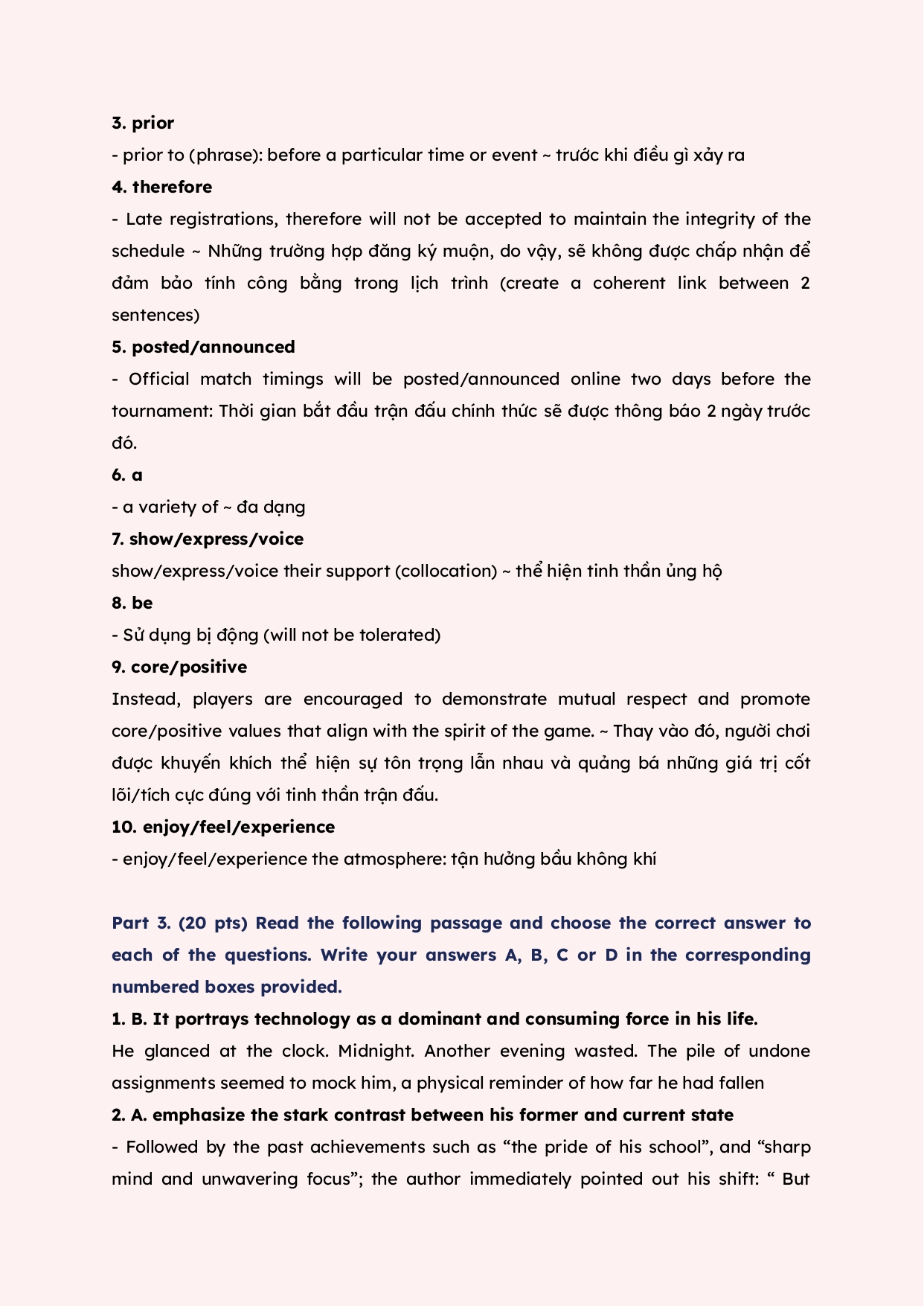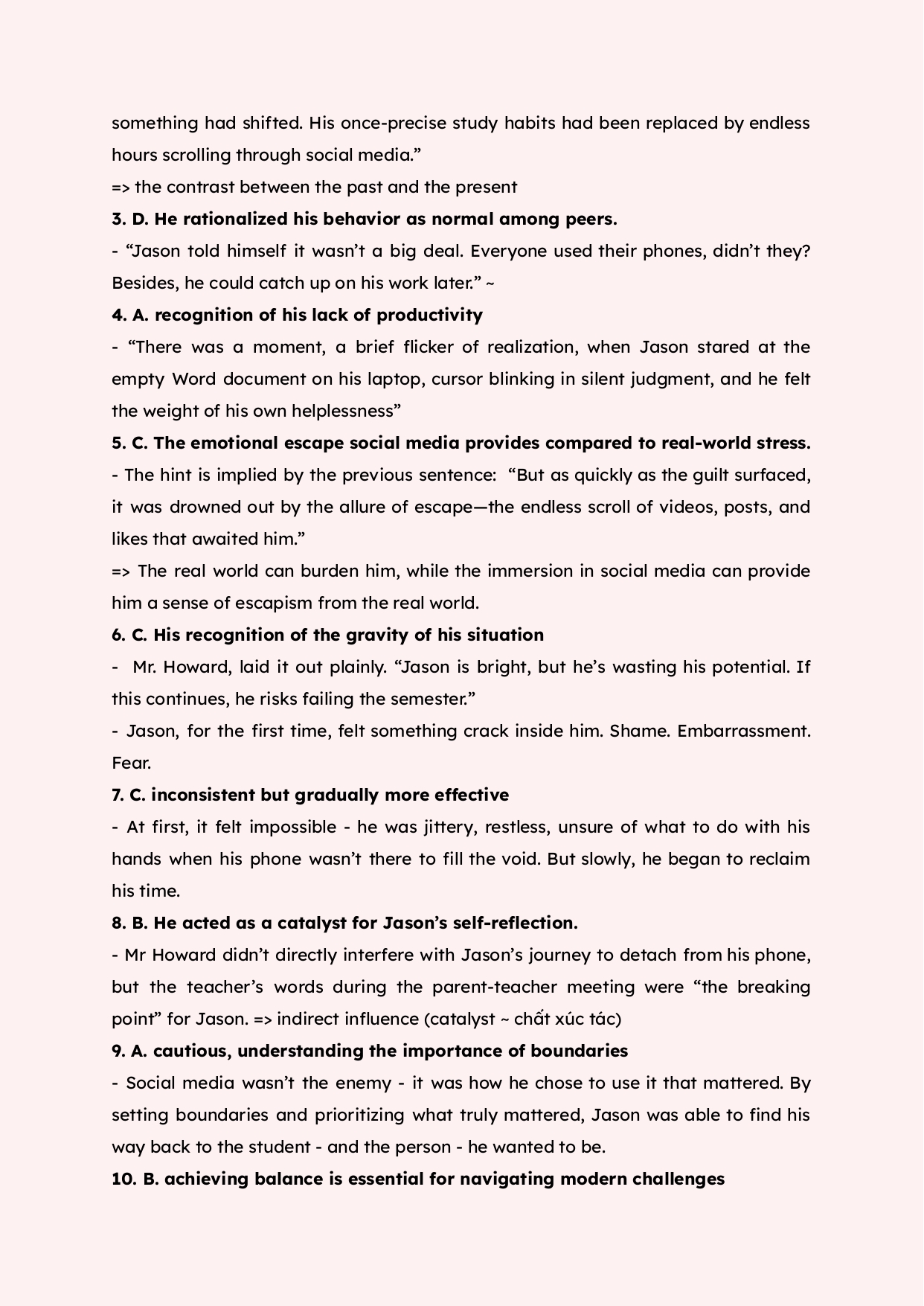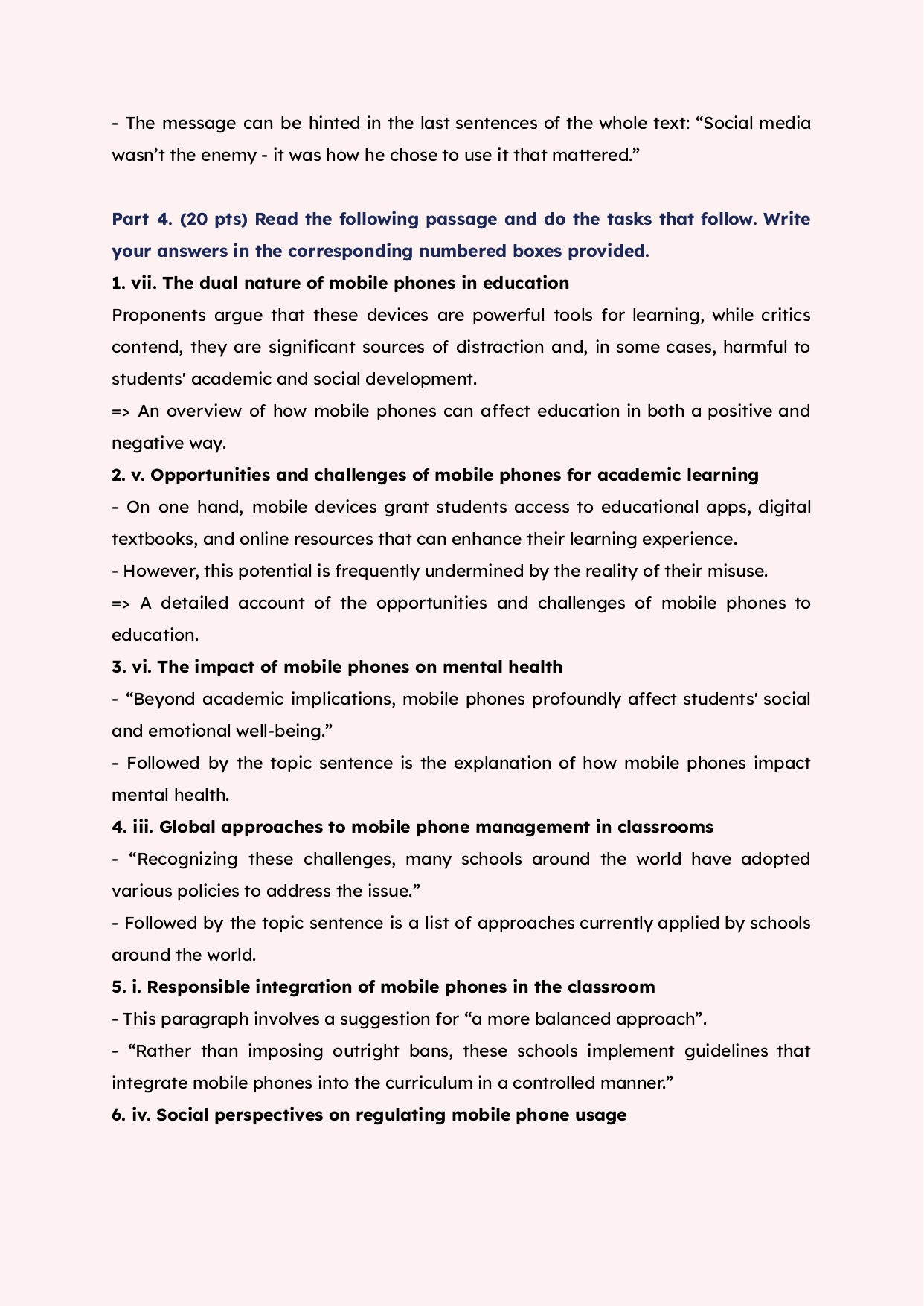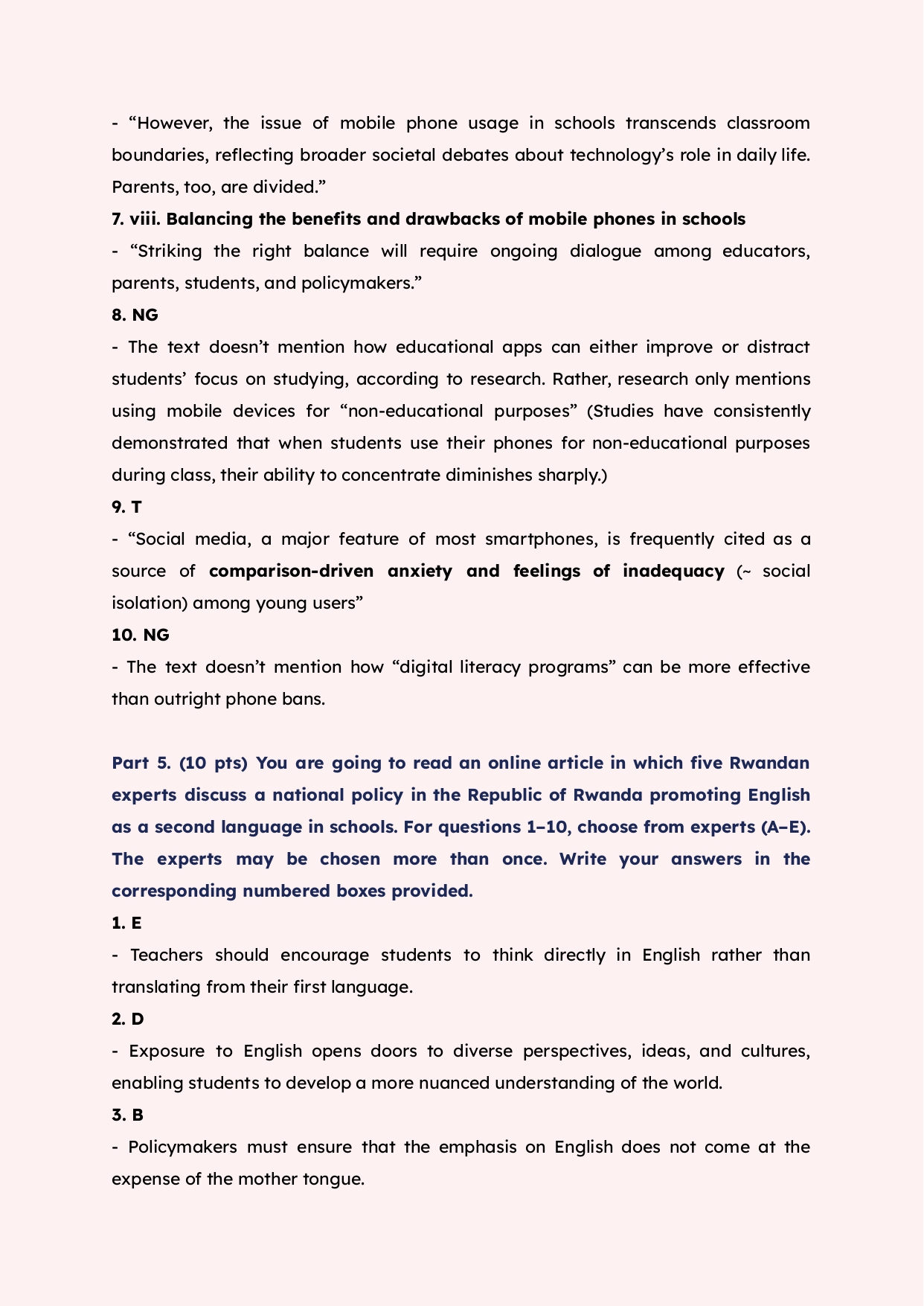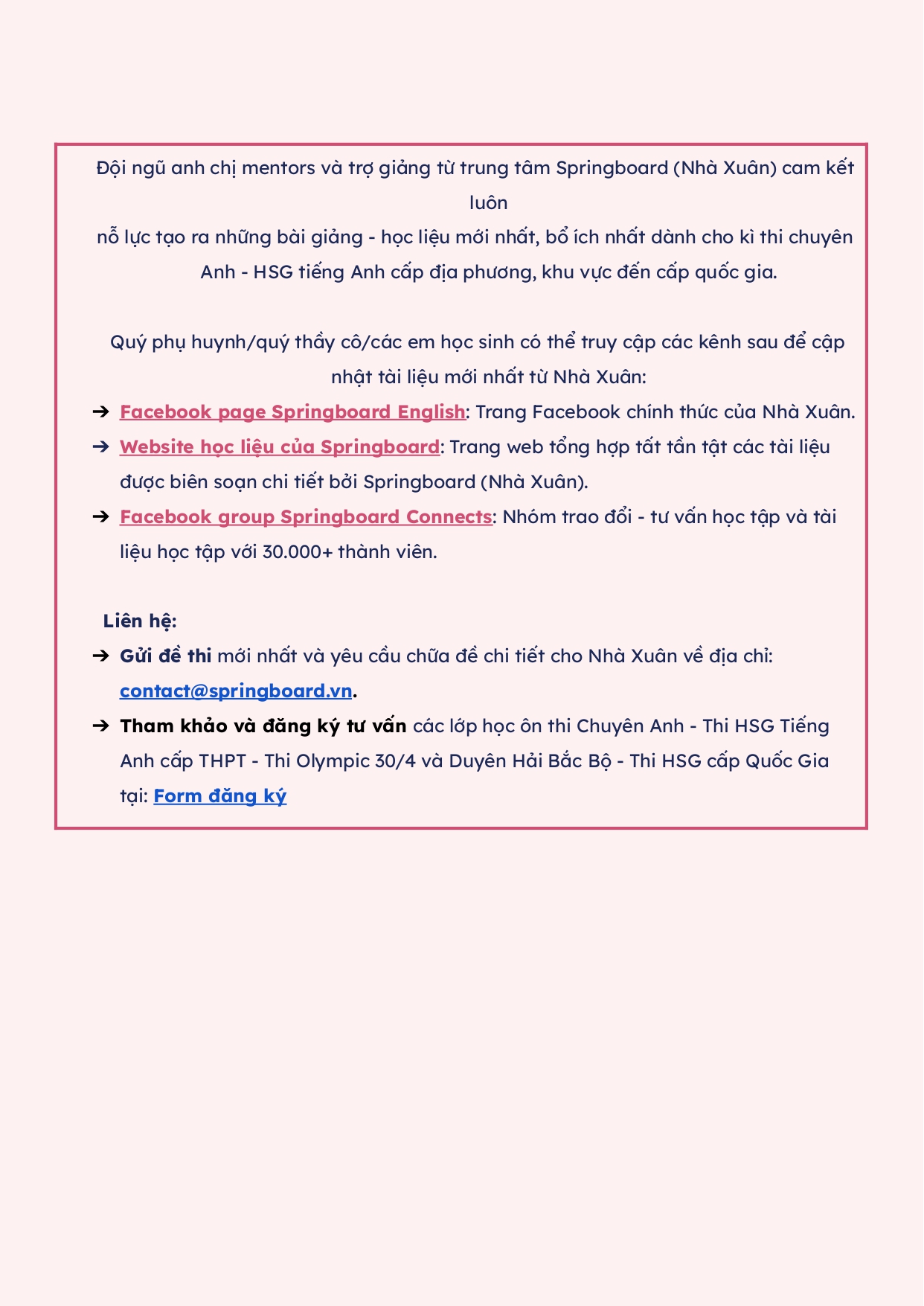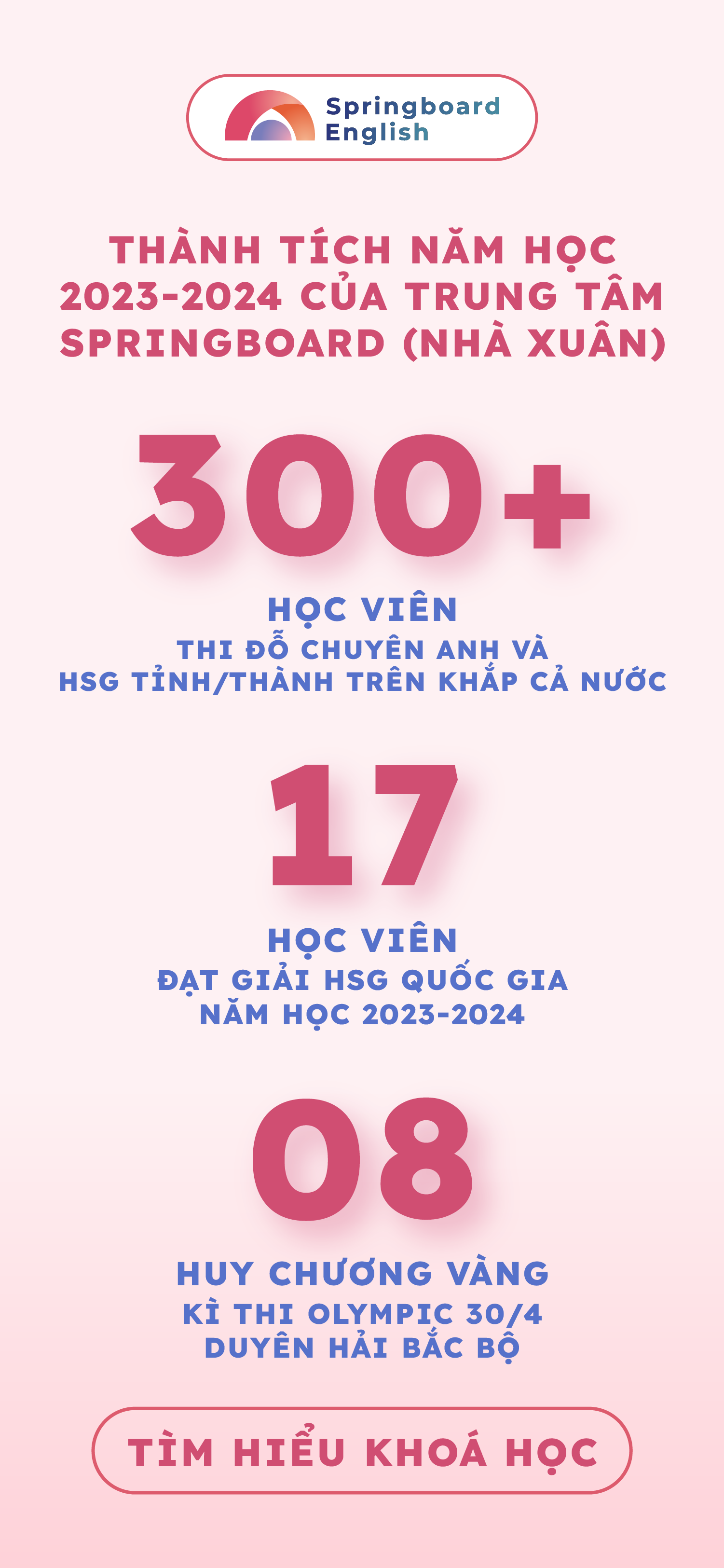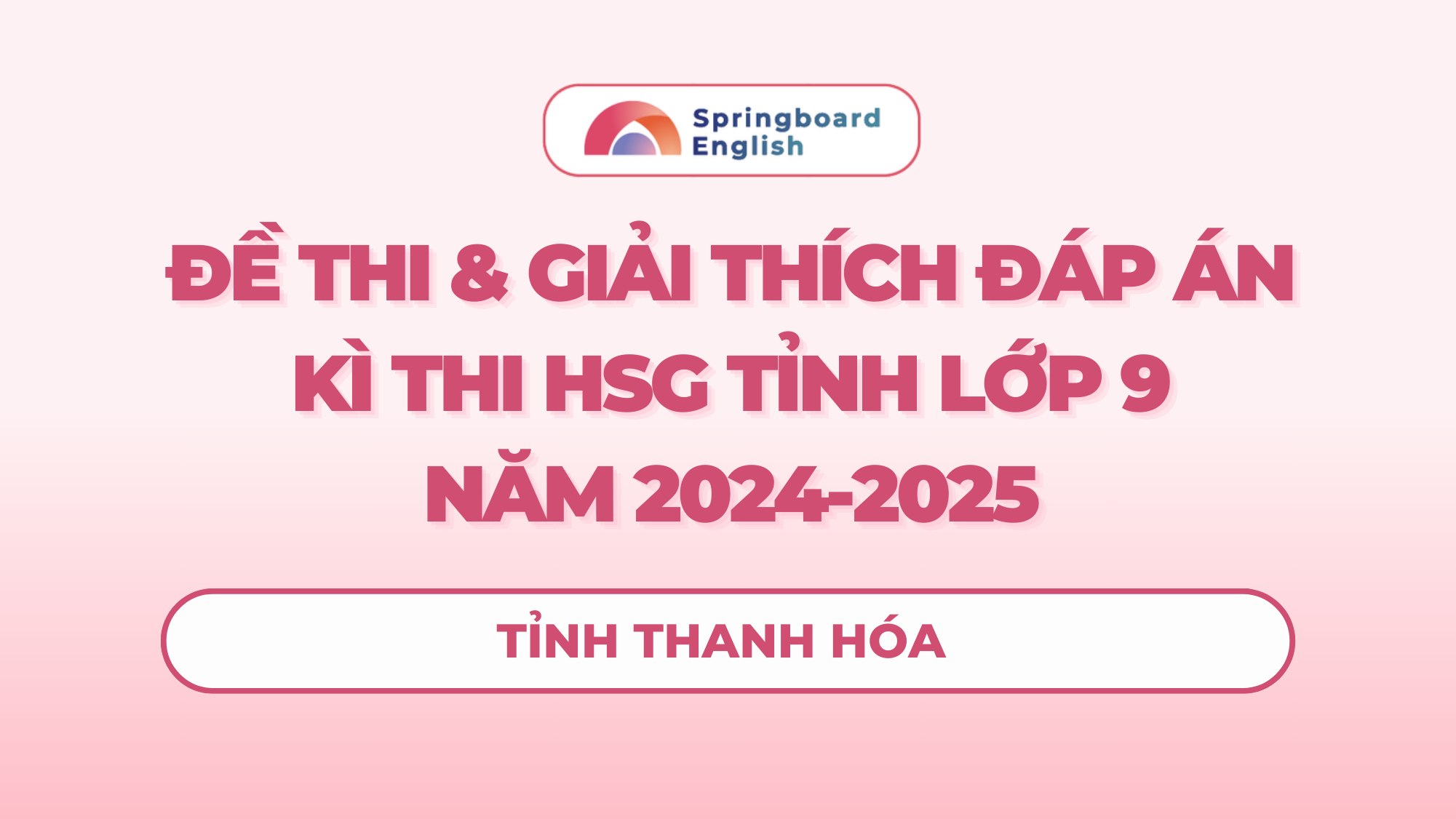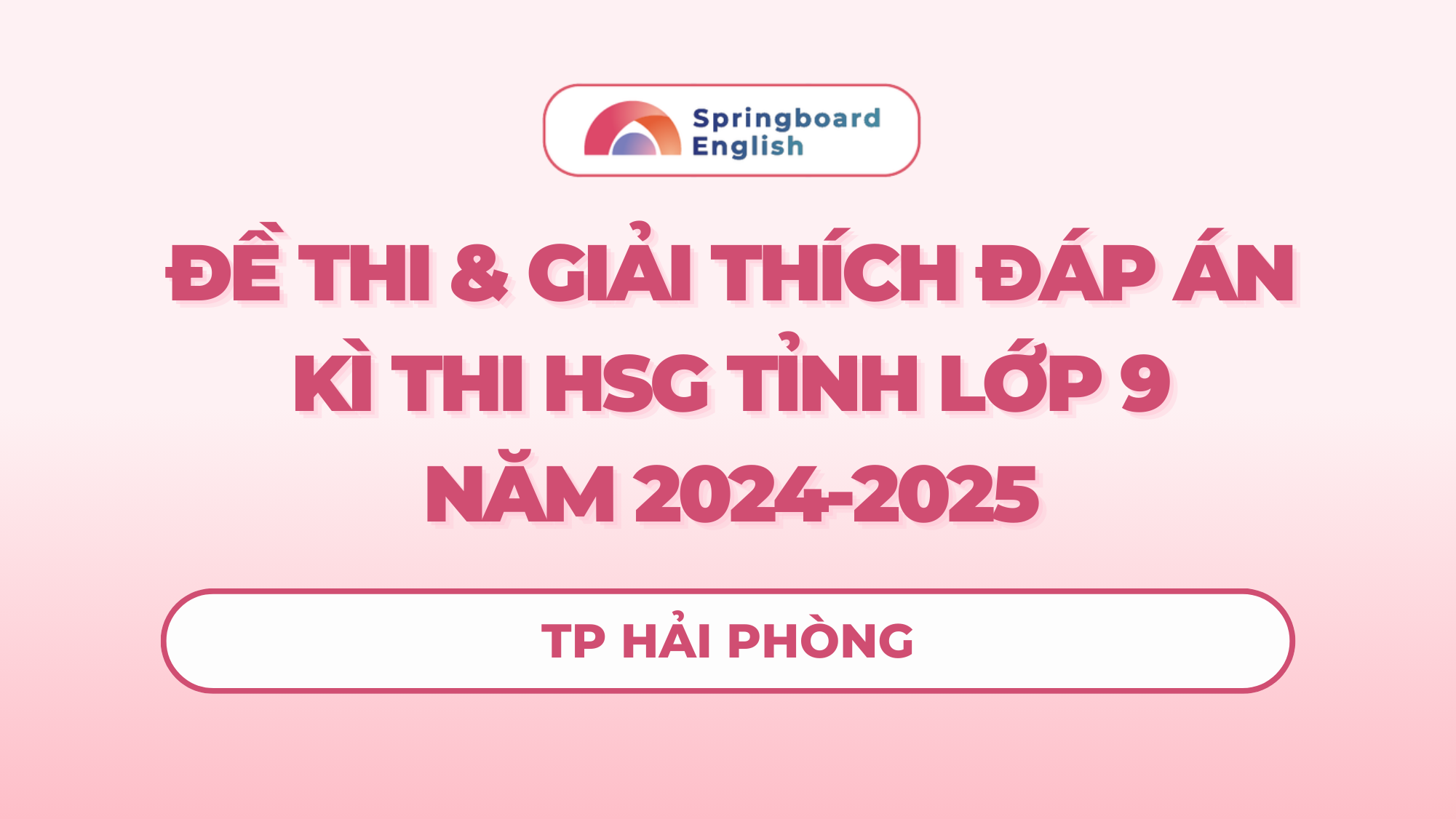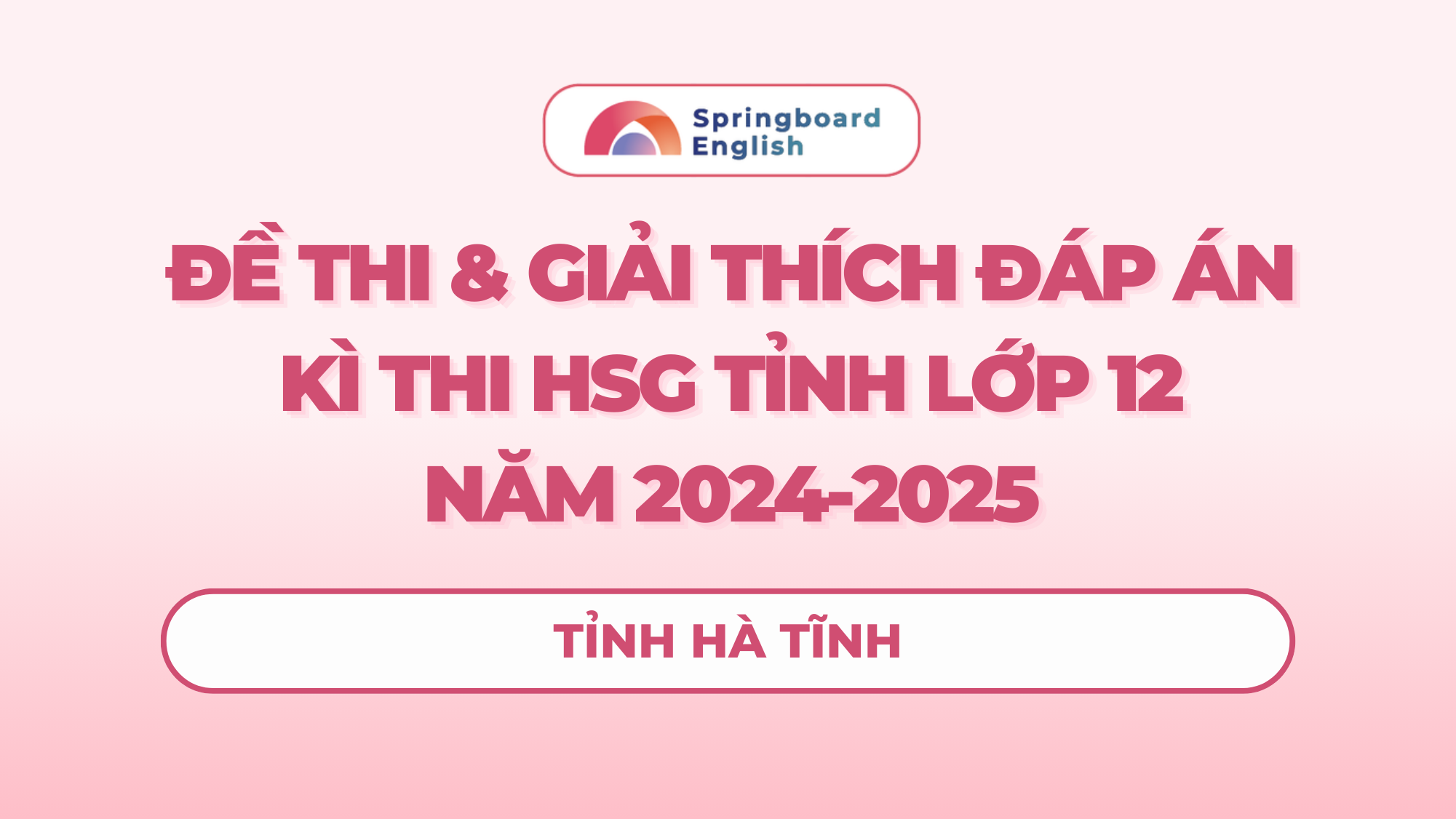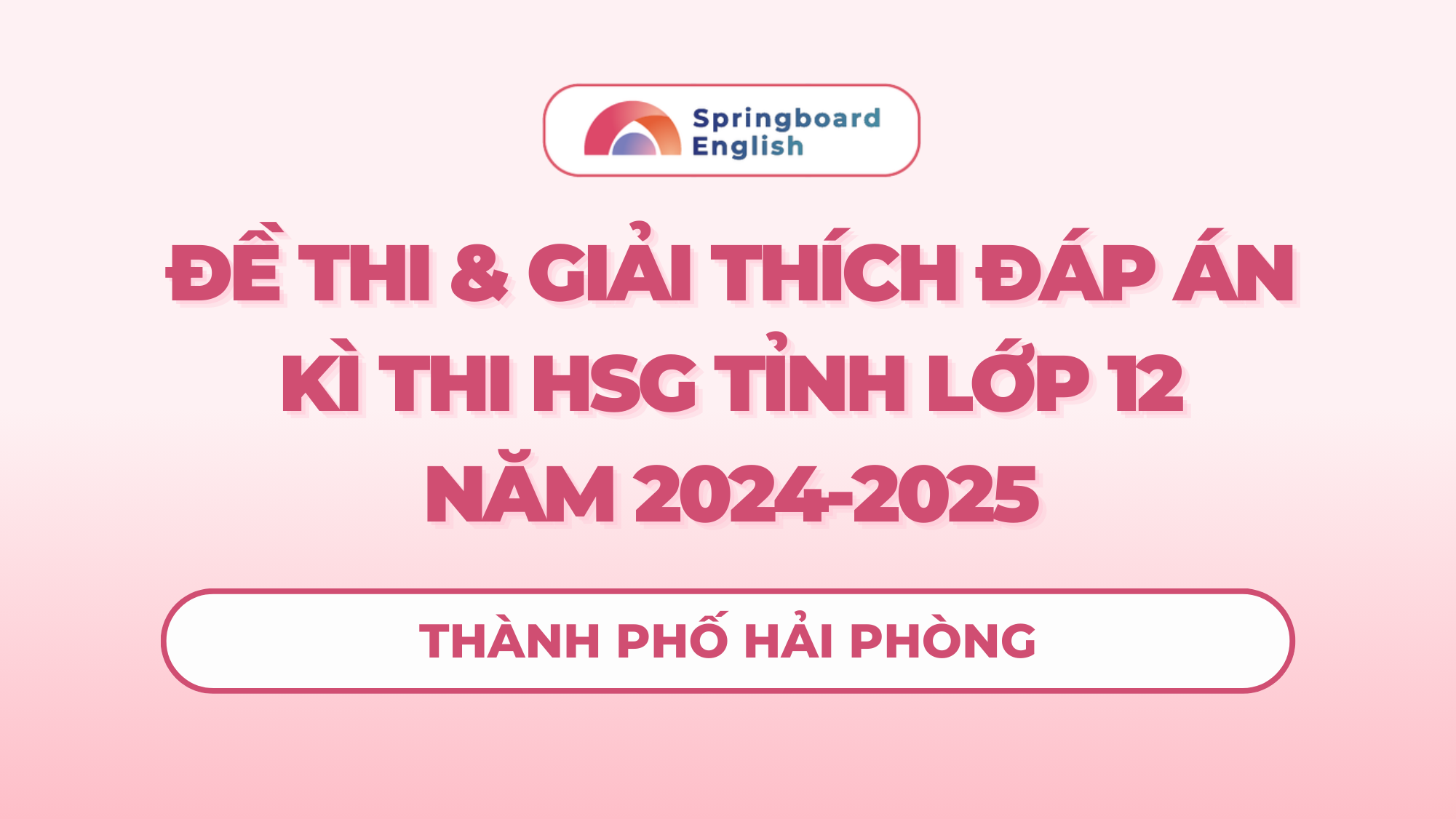Đề thi và Đáp án Chi tiết Kì thi Chọn HSG Tỉnh lớp 9 - Tỉnh Nghệ An (bảng A) năm học 2024-2025
Trong bài viết này, Đội ngũ trung tâm Springboard (Nhà Xuân) xin chia sẻ đến các quý phụ huynh, thầy cô, các em học sinh Đề thi và Đáp án có giải thích chi tiết ở kì thi chọn học sinh giỏi tỉnh Tiếng Anh lớp 9 – tỉnh Nghệ An (bảng A) năm học 2024-2025.
Phần đáp án chi tiết được giới thiệu ở bài viết này là tài liệu được biên soạn trực tiếp bởi đội ngũ chuyên môn Nhà Xuân, đồng thời là bản cập nhật mới nhất trong năm 2025.
Kéo xuống dưới cùng để xem hết đáp án có giải thích chi tiết.
Phần nghe - Đề thi chọn HSG lớp 9 tỉnh Nghệ An (bảng A) năm học 2024-2025
Đề thi HSG Tiếng Anh lớp 9 - tỉnh Nghệ An (bảng A) năm học 2024-2025
SỞ GIÁO DỤC VÀ ĐÀO TẠO NGHỆ AN (Đề gồm 14 trang) | KỲ THI CHỌN HỌC SINH GIỎI TỈNH LỚP 9 NĂM HỌC 2024 – 2025 Môn thi: TIẾNG ANH – BẢNG A Thời gian: 150 phút (không kể thời gian giao đề) | ||
ĐIỂM | HỌ TÊN, CHỮ KÍ GIÁM KHẢO | SỐ PHÁCH | |
Bằng số:………………………….. Bằng chữ:………………..………. | Giám khảo 1: …………………………… Giám khảo 2: …………………………… | ||
SECTION A. LISTENING (50 points)
Part 1. (30 pts) You will hear a talk. For questions 1-15, listen and complete the text below by writing NO MORE THAN THREE WORDS AND/OR A NUMBER in the spaces provided. Write your answers in the corresponding numbered boxes provided.
How friendship affects your brain
If it seems like friendships formed in adolescence are particularly special, that’s because they are. Early childhood, adolescent, and adult friendships all (1)______ a little differently in part because the brain works in different ways at those stages of life. Adolescence is a (2)______ in which there are changes in the way you value, understand, and connect to friends. Scientists describe adolescence as (3)______ as teenagers begin to spend as much or more time with their friends than with their parents. This drive to hang with (4)______ may be due to changes in the brain’s reward center, known as the ventral striatum. Its (5)______ makes hanging out with others enjoyable and motivates you to spend more time with them. Neuroimaging studies may explain why adolescents seem to place a higher value on social (6)______ than children or adults. This deeper connection is possible thanks to (7)______ in what scientists call theory of mind. While it may seem intuitive, this ability hinges on the careful coordination of various brain regions, sometimes referred to as the social brain. Babies begin to develop theory of mind (8)______ or so.
Regions within the social brain show (9)______ during adolescence compared with childhood. As a result, teens can better understand their friends’ (10)______, allowing for deeper connections to flourish. In the closest friendships, it can almost feel as if you’re (11)______ connected two bodies and minds, perfectly in sync. Your ability to connect with others somewhat depends on the coordination of actions, emotions, (12)______, and thoughts. This is what psychologists call (13)______ synchrony.
You first show signs of the ability to sync with others as infants synchronizing movements and (14)______ with your parents. As you get older and spend more time outside the home, you increasingly show this synchrony with your peers. For example, imagine walking down the street with a friend. Often without consciously thinking, you (15)______ at the same pace and follow the same path.
Your answers:
1. | 2. | 3. |
4. | 5. | 6. |
7. | 8. | 9. |
10. | 11. | 12. |
13. | 14. | 15. |
Part 2 (10 points):
Questions 16-19. Choose the correct letter A, B or C.
Holly’s Work Placement Tutorial
16. Holly has chosen the Orion Stadium placement because ______.
it involves children
it is outdoors
it sounds like fun
17. Which aspect of safety does Dr Green emphasise most?
Ensuring children stay in the stadium
Checking the equipment children will use
Removing obstacles in changing rooms
18. What does Dr Green say about the spectators?
They can be hard to manage.
They make useful volunteers.
They shouldn’t take photographs.
19. What has affected the schedule in the past?
Bad weather
An injury
Extra time
Questions 20-25
What do Holly and her tutor agree is an important aspect of each of the following events management skills?
Choose SIX answers from the box and write the correct letter, A-H, next to Questions 20-25.
Important aspects
A. being flexible | E. relying on experts |
B. focusing on details | F. trusting your own views |
C. having a smart appearance | G. doing one thing at a time |
D. hiding your emotions | H. thinking of the future |
Events management skills
20. Communication __________ | 23. Creativity __________ |
21. Organisation __________ | 24. Leadership __________ |
22. Time management __________ | 25. Networking __________ |
Your answers:
16. | 17. | 18. | 19. | 20. |
21. | 22. | 23. | 24. | 25. |
Part 3. (10 pts) For questions 26-30, listen to a talk on people’s emotional links with food and decide whether the following statements are True (T) or False (F). Write your answers in the corresponding numbered boxes.
26. When eating with someone who is consuming a substantial amount of food, we tend to choose a smaller portion.
27. Sharing food among groups would have been crucial in reducing the risk of starvation.
28. While evolutionary mechanisms still shape our eating habits, they can lead to overeating in social contexts.
29. There is no indication that people commonly attach meanings to particular foods.
30. We might eat more of a food linked to positive emotions and memories, and as this connection deepens, our tendency to indulge in it grows.
Your answers:
26. | 27. | 28. | 29. | 30. |
SECTION B. LEXICO – GRAMMAR (20 points)
Part 1. (12 pts) Choose the best answer to complete each of the following sentences. Write A, B, C or D in the corresponding numbered boxes provided.
1. Geometry is the branch of mathematics ______ the properties and relation of lines, angles, shapes, surfaces and solids.
is concerned with B. the deal about
dealing with D. to be concerned about
2. The local authority had to evacuate thousands of people after the ______ force of the storm warning was given.
destroy B. destructively C. destructive D. destruction
3. The dress is a little big for you. You’d better go to tailor’s and ______ at the waist.
make it less wide B. have it made wider
make it wider D. have it made less wide
4. The weather conditions ______ throughout the day and now the ground officials are confident that the championship game ______ ahead.
have been improving / will go B. will be improving / will go
have improved / was going D. are improving / has gone
5. The children were heavily dressed ______ catching a cold.
due to B. despite C. because of D. for fear of
6. – “What’s your opinion of the new supervisor?”
– “______ spoken to her yet, I can’t say.”
Not to have B. Having not to C. Not having D. My having not
7. The recommendation that all people affected by the storm ______ immediately was approved.
evacuating B. be evacuated C. evacuated D. being evacuated
8. I hope you realize that you will be ______ responsible for your actions should you get caught.
brought B. taken C. carried D. held
9. Deadlines are getting closer and everyone is rushed off their ______ at the moment!
feet B. eyes C. hands D. teeth
Choose the correct answer A, B, C, or D to indicate the word(s) CLOSEST in meaning to the underlined word(s) in the following question.
Losing was bad enough. Watching their rival receiving the trophy just rubbed salt into the wound.
make a difficult situation worse B. add salt into a tasteless soup
make a dilemma much better D. remove a scar from the injury
Choose the correct answer A, B, C, or D to indicate the word(s) OPPOSITE in meaning to the underlined word(s) in the following question.
Peter’s parents do not give him permission to ride a motorbike, but he still uses his father’s on the sly sometimes.
secretly B. freely C. willingly D. publicly
Choose the correct answer A, B, C, or D to indicate the sentence that best completes the following exchange.
12. Jane: “I heard you have a part in the school play tonight.”
Tom: ” ______”
Yes, and I’m on pins and needles. B. Yes, and I’m in deep water.
Yes, and I’m black and blue. D. Yes, and I’m at my wits’ end.
Your answers:
1. | 2. | 3. | 4. |
5. | 6. | 7. | 8. |
9. | 10. | 11. | 12. |
Part 2. (8 pts) Read the passage below, which contains 8 mistakes. Identify the mistakes and write the corrections in the corresponding numbered boxes provided.
Line 1 2 3 4 5 6 7 8 9 10 11 12 13 14 | XpertMind is the cutting-edge AI app designed to revolutionize the way you learn and work. Using advanced AI technology, XpertMind provides a personalized approach to improve your study habits, enhancing productivity, and optimizing your performance across various field. Whether you’re preparing for academic exams, mastering a new skill, and refining your professional expertise, XpertMind adapts for your needs with unmatched precision. The app’s standout features include tailored learning plans, expert-level response in multiple subjects, and powerful tools to improve your writing, critical thinking, and presenting skills. XpertMind’s advanced algorithms give in-depth feedback, encourage you to explore new perspectives and challenge your assumptions. With this, you’ll develop essential problem-solving and analytical skills, helping you excel in any task you take on. Designing for learners at all levels, from beginners (A1) to experts (C2), XpertMind offers customized content what grows with you. The app adjusts based on your progress, ensuring you receive relevant support at each stage. It’s perfect for refining your English proficiency, boosting academic performance, or optimizing your professional efficiency. |
Your answers:
Line | Mistake | Correction | Line | Mistake | Correction | ||
1. | 5. | ||||||
2. | 6. | ||||||
3. | 7. | ||||||
4. | 8. |
SECTION C. READING (70 points)
Part 1. (10 pts) Read the announcement and choose the best answer. Write your answers A, B, C or D in the corresponding numbered boxes provided.
ANNOUNCEMENT: ACADEMIC ENRICHMENT WEEK
The Academic Enrichment Week, commencing next Monday, promises an intensive program aimed at fostering intellectual development and critical thinking. This event has been meticulously (1)______ to provide students with opportunities to explore advanced concepts, challenge conventional ideas, and collaborate with peers and experts alike.
A key feature of the program is a series of workshops and lectures delivered by (2)______ professionals across disciplines such as artificial intelligence, environmental science, and global economics. These sessions aim to encourage deep (3)______ and facilitate meaningful discussions, allowing participants to engage with complex issues on a profound level.
One of the highlights of the week is the Innovators’ Forum, where students are encouraged to present innovative (4)______ to global challenges. Successful proposals must (5)______ creativity with practicality, with winning teams earning financial grants to further develop their projects and showcase their solutions at national events.
Attendance at morning sessions is mandatory, (6)______ they align closely with the academic curriculum. Afternoon sessions, though optional, are curated to promote interdisciplinary collaboration and foster the (7)______ of perspectives, encouraging students to think (8)______ the box.
Students are expected to maintain (9)______ professionalism throughout the event, as this week also emphasizes skills vital for future endeavors and career advancement. We encourage all students to take full (10)______ of this unique opportunity.
1. A. constructed designed C. simplified D. revised
2. A. aspiring renowned C. emerging D. reluctant
3. A. reflection interaction C. assignation D. exploration
4. A. approaches solutions C. perspectives D. discussions
5. A. blend replace C. contrast D. refine
6. A. but unless C. although D. as
7. A. intensity expression C. diversity D. evaluation
8. A. inside outside C. upon D. into
9. A. impeccable questionable C. hesitant D. indifferent
10. A. advantage advancement C. assignment D. situation
Your answers:
1. | 2. | 3. | 4. | 5. |
6. | 7. | 8. | 9. | 10. |
Part 2. (10 pts) Read the announcement below and fill in each gap with ONE suitable word. Write the answers in the corresponding numbered boxes provided.
ANNUAL PICKLEBALL TOURNAMENT
We are delighted to announce the Annual Pickleball Tournament, which will take place next Saturday at the Riverside Sports Complex. This eagerly anticipated event aims to (1)______ players of all levels, from beginners to seasoned athletes, in a celebration of both skill and camaraderie.
The tournament will be (2)______ into singles and doubles categories, further classified by age and skill levels. Participants are required to register by midnight this Wednesday, ensuring that all forms and fees are submitted (3)______ to the deadline. Late registrations, (4)______, will not be accepted to maintain the integrity of the schedule.
Matches will take place on professional-grade courts, ensuring fairness and optimal playing conditions. Official match timings will be (5)______ online two days before the tournament. In addition, spectators are encouraged to attend and enjoy (6)______ variety of activities, including food stalls, live commentary, and exclusive merchandise for those wishing to (7)______ their support for the sport.
Participants are reminded to follow the rules and maintain exemplary sportsmanship. Behavior that disrupts the event or disrespects others will not (8)______ tolerated. Instead, players are encouraged to demonstrate mutual respect and promote (9)______ values that align with the spirit of the game.
Whether you’re aiming to compete or simply (10)______ the atmosphere, this tournament offers something for everyone. Join us in celebrating the fastest-growing sport in the country!
Your answers:
1. | 2. | 3. | 4. | 5. |
6. | 7. | 8. | 9. | 10. |
Part 3. (20 pts) Read the following passage and choose the correct answer to each of the questions. Write your answers A, B, C or D in the corresponding numbered boxes provided.
A MODERN TRAP
Jason sat slouched at his desk, the glow of his phone illuminating his face in the dimly lit room. The silence was interrupted only by the occasional ping of a notification, drawing his attention away from the textbook that lay open before him. He glanced at the clock. Midnight. Another evening wasted. The pile of undone assignments seemed to mock him, a physical reminder of how far he had fallen.
Just a year ago, Jason had been the pride of his school. Teachers praised his sharp mind and unwavering focus, and his classmates envied his ability to juggle extracurriculars and academics with ease. But something had shifted. His once-precise study habits had been replaced by endless hours scrolling through social media. What began as a five-minute break had spiraled into hours of mindless consumption.
Jason told himself it wasn’t a big deal. Everyone used their phones, didn’t they? Besides, he could catch up on his work later. But “later” never seemed to come. His grades plummeted, and the disapproving looks from his teachers were joined by the worried glances of his parents. “Why can’t you focus anymore, Jason?” his mother had asked one evening. He didn’t have an answer.
He wasn’t entirely oblivious to the problem. There was a moment, a brief flicker of realization, when Jason stared at the empty Word document on his laptop, cursor blinking in silent judgment, and he felt the weight of his own helplessness. But as quickly as the guilt surfaced, it was drowned out by the allure of escape—the endless scroll of videos, posts, and likes that awaited him. The real world felt heavy; the digital one, effortless.
The breaking point came during a parent-teacher meeting. His physics teacher, Mr. Howard, laid it out plainly. “Jason is bright, but he’s wasting his potential. If this continues, he risks failing the semester.” His parents were devastated, and Jason, for the first time, felt something crack inside him. Shame. Embarrassment. Fear.
It wasn’t easy to admit the problem. Social media had become more than a habit; it was a refuge. But Jason knew he had to act. He started small. First, he deleted a few apps. Then, he downloaded one designed to limit his screen time. At first, it felt impossible – he was jittery, restless, unsure of what to do with his hands when his phone wasn’t there to fill the void. But slowly, he began to reclaim his time.
He rediscovered his love for reading, devouring novels he had once ignored in favor of memes and videos. He spent afternoons at the library, where the quiet forced him to confront his work without the safety net of his phone. It was far from perfect – there were relapses, nights when he couldn’t resist the pull of his notifications – but progress came in small victories.
One evening, as he finished the last problem on his math worksheet, Jason felt a flicker of pride he hadn’t experienced in months. His grades began to recover, and so did his confidence. When Mr. Howard returned a graded test with an A circled at the top, Jason could barely contain his grin. “Welcome back,” Mr. Howard said with a knowing nod.
Jason’s journey was far from over, but he had learned something valuable: balance. Social media wasn’t the enemy – it was how he chose to use it that mattered. By setting boundaries and prioritizing what truly mattered, Jason was able to find his way back to the student – and the person – he wanted to be.
1. What does the phrase “the glow of his phone illuminating his face” in paragraph 1 metaphorically suggest about Jason’s relationship with technology?
It signifies a harmless dependence on technology for daily activities.
It portrays technology as a dominant and consuming force in his life.
It emphasizes his preference for technology over real-world interactions.
It indicates his deliberate choice to prioritize technology at night.
2. The description of Jason’s past achievements serves to ______.
emphasize the stark contrast between his former and current state
provide a justification for why teachers were disappointed in him
highlight the role of external validation in his academic success
demonstrate the unsustainable nature of his earlier habits
3. What does the passage imply about Jason’s initial defense of his social media usage?
He believed social media could strengthen friendships.
He thought his use of social media was healthy.
He saw social media as an escape from reality.
He rationalized his behavior as normal among peers.
4. The phrase “cursor blinking in silent judgment” in paragraph 4 most likely reflects Jason’s _____.
recognition of his lack of productivity
irritation at the distractions caused by technology
understanding of how far behind he was falling
feeling of being judged by his surroundings
5. What contrast is the author drawing in the sentence “The real world felt heavy; the digital one, effortless.” of paragraph 4?
The contrast between working hard and taking breaks.
The difference between pursuing goals and procrastinating.
The emotional escape social media provides compared to real-world stress.
The convenience of digital life over real-world obligations.
6. Which aspect of Jason’s emotional state is most evident during the parent-teacher meeting?
His frustration with his parents’ inability to understand him.
His anger at being publicly criticized by his teacher.
His recognition of the gravity of his situation.
His regret for not addressing the issue earlier.
7. The passage describes Jason’s initial attempts to change his habits as ______.
calculated but hindered by external distractions
reluctant and motivated by pressure from others
inconsistent but gradually more effective
intense but ultimately unsustainable
8. What can be inferred about the role of Mr. Howard in Jason’s journey?
He provided a structured plan for Jason’s recovery.
He acted as a catalyst for Jason’s self-reflection.
He directly intervened to help Jason manage his time.
He symbolized the broader expectations of society.
9. By the end of the passage, Jason’s attitude toward social media can best be described as ______.
cautious, understanding the importance of boundaries
unwilling to rely on it again for comfort
indifferent, having lost interest in its role in his life
focused on entirely avoiding social media
10. The overarching message of the passage suggests that ______.
regaining control over one’s habits requires external intervention
achieving balance is essential for navigating modern challenges
abandoning digital technology is key to personal and academic success
societal pressures often exacerbate individual struggles
Your answers:
1. | 2. | 3. | 4. | 5. |
6. | 7. | 8. | 9. | 10. |
Part 4. (20 pts) Read the following passage and do the tasks that follow. Write your answers in the corresponding numbered boxes provided.
THE COMPLEX IMPACT OF MOBILE PHONES IN EDUCATION
A
In the digital era, mobile phones have seamlessly integrated into almost every aspect of modern life, particularly among younger generations. With their unprecedented ability to provide instant communication, access to vast resources, and advanced tools, mobile phones have become a ubiquitous presence, even in educational settings. Yet, this integration has sparked a contentious debate. Proponents argue that these devices are powerful tools for learning, while critics contend, they are significant sources of distraction and, in some cases, harmful to students’ academic and social development. The conflicting perspectives raise the question: should mobile phones be embraced as educational aid or strictly regulated in schools?
B
From an academic standpoint, the presence of mobile phones in schools presents a double-edged sword. On one hand, mobile devices grant students access to educational apps, digital textbooks, and online resources that can enhance their learning experience. Research has shown that using mobile phones for tasks such as conducting quick research, participating in interactive exercises, or watching instructional videos can foster engagement, particularly for visual and auditory learners. However, this potential is frequently undermined by the reality of their misuse. Studies have consistently demonstrated that when students use their phones for non-educational purposes during class, their ability to concentrate diminishes sharply. Notifications from social media platforms, messages from friends, and the lure of entertainment apps often lead to reduced comprehension and lower retention of material.
C
Beyond academic implications, mobile phones profoundly affect students’ social and emotional well-being. Social media, a major feature of most smartphones, is frequently cited as a source of comparison-driven anxiety and feelings of inadequacy among young users. While many students seek validation through likes and comments, the curated and often unrealistic portrayals of others’ lives can erode self-esteem and exacerbate mental health issues such as anxiety and depression. Additionally, the reliance on mobile phones for communication has been linked to a decline in face-to-face interactions, weakening students’ ability to develop essential interpersonal skills. In school settings, the continuous distractions caused by these devices not only interfere with peer relationships but can also erode respect for authority and disrupt classroom harmony.
D
Recognizing these challenges, many schools around the world have adopted various policies to address the issue. A popular approach is the outright ban of mobile phones during school hours, often enforced by requiring students to store their devices in lockers or leave them at home. Proponents of this policy argue that it creates a focused learning environment, free from unnecessary distractions. Educators in such schools frequently report improvements in classroom behavior, increased participation, and enhanced academic outcomes. Yet, critics of outright bans point out that these policies may overlook an important opportunity: teaching students how to use technology responsibly. By banning phones, they argue, schools fail to prepare students for a world where mobile devices are integral to professional and personal life.
E
For some educators, the solution lies in a more balanced approach. Rather than imposing outright bans, these schools implement guidelines that integrate mobile phones into the curriculum in a controlled manner. For example, phones might be used during specific lessons for research, group collaboration, or educational games, with strict monitoring to prevent misuse. Additionally, some schools introduce digital literacy programs, teaching students not only how to use their devices effectively but also how to recognize and manage the negative effects of overuse. This dual approach aims to harness the benefits of mobile phones while addressing their potential harms, fostering both academic success and digital responsibility.
F
However, the issue of mobile phone usage in schools transcends classroom boundaries, reflecting broader societal debates about technology’s role in daily life. Parents, too, are divided. While some advocate for strict regulations, believing that phones hinder academic performance and social development, others argue that phones are necessary for safety and convenience. The latter group highlights situations such as emergencies, where immediate communication with their children can be crucial. Meanwhile, policymakers grapple with crafting regulations that balance these competing concerns while considering the long-term implications for education systems increasingly reliant on technology.
G
As mobile phones continue to evolve, their role in education is likely to remain a complex and dynamic issue. Striking the right balance will require ongoing dialogue among educators, parents, students, and policymakers. By fostering open conversations and experimenting with innovative strategies, schools can create environments that not only mitigate the drawbacks of mobile phone usage but also maximize their potential as tools for learning and development.
Questions 1 – 7
The reading passage has six sections, A-G.
Choose the correct heading for each section from the list of headings below.
Write the correct number i-xi in boxes 1-7 on your answer sheet.
List of Headings i. Responsible integration of mobile phones in the classroom ii. Diverse strategies for managing mobile phone use within schools iii. Global approaches to mobile phone management in classrooms iv. Social perspectives on regulating mobile phone usage v. Opportunities and challenges of mobile phones for academic learning vi. The impact of mobile phones on mental health vii. The dual nature of mobile phones in education viii. Balancing the benefits and drawbacks of mobile phones in schools ix. Changing approaches to mobile phone policies in education x. Parents’ role in shaping students’ mobile phone habits xi. How mobile phones can support professional skill development |
1. Section A ______
2. Section B ______
3. Section C ______
4. Section D ______
5. Section E ______
6. Section F ______
7. Section G ______
Questions 8 – 10
Do the following statements agree with the information given in the reading passage? Write:
TRUE if the statement agrees with the information
FALSE if the statement contradicts the information
NOT GIVEN if there is no information on this
8. Research confirms that educational apps significantly improve students’ focus during lessons.
9. Students who rely heavily on mobile phones often experience social isolation.
10. Digital literacy programs are more effective than outright phone bans in schools.
Your answers:
1. | 2. | 3. | 4. | 5. |
6. | 7. | 8. | 9. | 10. |
Part 5. (10 pts) You are going to read an online article in which five Rwandan experts discuss a national policy in the Republic of Rwanda promoting English as a second language in schools. For questions 1–10, choose from experts (A–E). The experts may be chosen more than once. Write your answers in the corresponding numbered boxes provided.
Which expert makes the following statements?
1. Students should practice using English directly rather than translating from their first language.
2. Learning English helps students develop a better understanding of global issues.
3. Policymakers should ensure that emphasis on English does not diminish the importance of the native language.
4. Teachers must receive proper training and resources for the policy to succeed.
5. It is important for students to learn how English is used in different cultural contexts.
6. Bilingual programs are more effective than focusing on a single language.
7. Public campaigns should address concerns about cultural identity loss caused by the new policy.
8. Schools need updated resources and teaching tools to implement the policy successfully.
9. English lessons should focus on real-world communication skills rather than theoretical knowledge.
10. Financial assistance might be necessary for low-income families to participate fully in the program.
Promoting English as a Second Language in Schools: Five Experts Share Their Views
In an increasingly interconnected world, English has emerged as a global lingua franca. Recognizing this, many non-English-speaking nations have adopted policies to integrate English as a second language (ESL) in their education systems. One such initiative is currently being implemented in our country, where policymakers hope to equip students with the tools needed to thrive in the global economy. However, this ambitious plan has sparked widespread debate among educators, parents, and linguists. Below, five experts weigh in on the potential benefits, challenges, and implications of this policy.
A
The global importance of English in today’s world cannot be overstated. It is the language of international business, science, technology, and diplomacy. By ensuring students acquire strong English skills, the policy aims to prepare them for a competitive global job market. However, the approach to teaching English must focus on developing practical, real-world communication skills rather than rote memorization of grammar rules and vocabulary. Modern English instruction should emphasize listening and speaking, enabling students to engage in meaningful conversations. Additionally, cultural competence plays a critical role in language learning. Students must understand the nuances of English as it is used in various cultural contexts, such as formal business meetings, casual social interactions, or academic debates. This cultural awareness not only enhances language proficiency but also prepares students to navigate diverse social and professional settings with confidence.
B
While the benefits of learning English are undeniable, it is crucial to ensure that this policy does not lead to the erosion of students’ mother tongue. A person’s native language is often deeply tied to their cultural identity and heritage. Policymakers must ensure that the emphasis on English does not come at the expense of the mother tongue. A strong foundation in the native language is essential for cognitive development, critical thinking, and even learning other languages effectively. One practical solution is the implementation of bilingual education programs, which allow students to develop proficiency in both languages simultaneously. Research shows that such programs are more effective than those that focus solely on one language at the expense of another. Moreover, schools should encourage students to appreciate the richness of their cultural heritage, promoting a sense of pride in their identity while embracing the opportunities English offers.
C
For any educational policy to succeed, it must be supported by well-trained and competent teachers. This is especially true for English language education. Many schools in our school do not have enough teachers who are proficient enough in English to deliver effective lessons. Without addressing this issue, the policy risks being ineffective. Policymakers need to invest heavily in teacher training programs to build the capacity of educators. Such programs should focus not only on improving teachers’ English proficiency but also on equipping them with modern pedagogical techniques, such as communicative language teaching and task-based learning. Additionally, schools require access to quality resources, including updated textbooks, multimedia tools, and digital platforms. Addressing these logistical and financial challenges is crucial for ensuring equitable access to quality ESL education across urban and rural areas. Economic barriers also play a significant role in the policy’s feasibility. For low-income families, purchasing supplementary materials or enrolling their children in additional English classes might be financially prohibitive. The government should subsidize costs or provide free learning resources to ensure that no student is left behind.
D
Beyond its practical utility, learning English also fosters critical thinking and global awareness. Exposure to English opens doors to diverse perspectives, ideas, and cultures, enabling students to develop a more nuanced understanding of the world. By engaging with texts and media in English, students can learn about global issues and explore viewpoints that challenge their pre-existing beliefs. However, policymakers must address potential resistance from communities concerned about cultural erosion. Some parents worry that prioritizing English might lead to a decline in the use of local languages and traditions. To mitigate these concerns, schools should work closely with families and community leaders to highlight how the policy complements, rather than replaces, cultural identity. Public awareness campaigns and community engagement initiatives can play a pivotal role in gaining widespread acceptance for the policy.
E
Implementing a bilingual education policy requires careful planning and execution. One common pitfall in ESL education is students’ over-reliance on their native language as a crutch when learning English. Teachers should encourage students to think directly in English rather than translating from their first language. Developing this habit helps students internalize English grammar and vocabulary, making their communication more natural and fluent. Another critical aspect is teaching students to appreciate the cultural and social contexts of English. Language is more than a set of rules; it is a tool for expressing thoughts, emotions, and ideas. By understanding the deeper layers of meaning in English texts, students can connect with the language on a more profound level. For example, exploring the literary and historical significance of idiomatic expressions or metaphors can help students develop both linguistic and cultural intelligence. Ultimately, the success of this policy hinges on its ability to balance practical language instruction with the preservation of cultural heritage. By taking a holistic approach, Our country can produce generations of bilingual citizens who are well-equipped to navigate the complexities of the modern world.
Your answers:
1. | 2. | 3. | 4. | 5. |
6. | 7. | 8. | 9. | 10. |
SECTION D. WRITING (60 points)
Part 1. (10 pts) Use the word given in brackets and make any necessary additions to complete a new sentence in such a way that it is as similar as possible in meaning to the original sentence. Do not change the form of the given word.
1. My company doesn’t let workers use phones for private purposes. (ALLOWED)
🡪 Workers __________________________________________ for private purposes.
2. Laura is so friendly that everyone wants to hang out with her. (SUCH)
🡪 Laura is ___________________________________________ hang out with her.
3. It’s a pity I can’t join a field trip with my classmates to the countryside. (ONLY)
🡪 If ________________________________________________ with my classmates to the countryside.
4. John couldn’t make a decision about whether to apply for membership or not. (MIND)
🡪 John ____________________________________________ whether to apply for membership or not.
5. Carolyn has accepted that she’ll never be selected for the team. (HERSELF)
🡪 Carolyn has _________________________________________ she’ll never be selected for the team.
Part 2. (20 pts) You recently heard about a proposal to organize new clubs in your school to help students develop their interests and skills. You believe this is a great idea and have some suggestions.
Write a letter (80-100 words) to the principal. DO NOT write your real name and any addresses. In your letter,
explain why you think organizing clubs is beneficial for students
suggest the types of clubs that should be introduced
explain how these clubs could be successfully managed
Part 3. (30 pts) Choose ONE of the following options:
Option 1: Your English teacher has asked you to write a story (200–250 words) for your school story writing competition. Your story should explore the theme of avoiding the use of mobile phones in school. Your story MUST begin with the following sentence:
It all started when Hana decided to check her phone during class, despite knowing the school’s strict rules.
Option 2: In some Vietnamese economically advanced localities, many schools offer an Intensive English Program (IEP) in collaboration with private English centers. These programs aim to improve students’ English proficiency by hiring native-speaking teachers and providing additional lessons outside the regular English curriculum. Participation is optional, and tuition fees are determined through agreements between schools and parents.
Some people believe that these programs are an effective way to enhance students’ English skills, while others argue that they create inequality among students and place a financial burden on families. To what extent do you agree or disagree with this view?
Give reasons for your answer and include any relevant examples from your own knowledge or experience.
Write at least 250 words
______ THE END ______
File PDF - Đề thi HSG Tiếng Anh lớp 9 tỉnh Nghệ An (bảng A) năm học 2024-2025
File PDF đề thi
Lời kết
Cảm ơn quý phụ huynh, thầy cô, và các em học sinh đã tham khảo tài liệu được biên soạn bởi Nhà Xuân.
Với nỗ lực để luôn tạo ra những bài giảng – học liệu hay nhất dành cho kì thi chuyên Anh – HSG tiếng Anh cấp tỉnh/thành phố đến cấp Quốc Gia, đội ngũ mentors trung tâm Springboard (Nhà Xuân) luôn biên soạn những tài liệu mới nhất với giải thích tận tâm – chi tiết.
Quý phụ huynh/ quý thầy cô/các em học sinh có thể truy cập các kênh sau để cập nhật tài liệu mới nhất từ Nhà Xuân:
- Facebook page Springboard English: Trang Facebook chính thức của Nhà Xuân
- Facebook group Springboard Connects: Nhóm trao đổi – tư vấn học tập, và tài liệu học tập với 30.000+ thành viên
- Website học liệu – springboard.vn :Trang web tổng hợp tất tần tật các tài liệu được biên soạn chi tiết bởi Springboard (Nhà Xuân).
Liên hệ:
- Gửi đề thi mới nhất cho Nhà Xuân về địa chỉ: contact@springboard.vn
- Tham khảo và đăng ký tư vấn các lớp học ôn thi Chuyên Anh – Thi HSG Tiếng Anh cấp THPT – Thi Olympic 30/4 và Duyên Hải Bắc Bộ – Thi HSG cấp Quốc Gia tại: Form đăng ký tư vấn.
Thân ái,
Đội ngũ trung tâm Springboard (Nhà Xuân)


